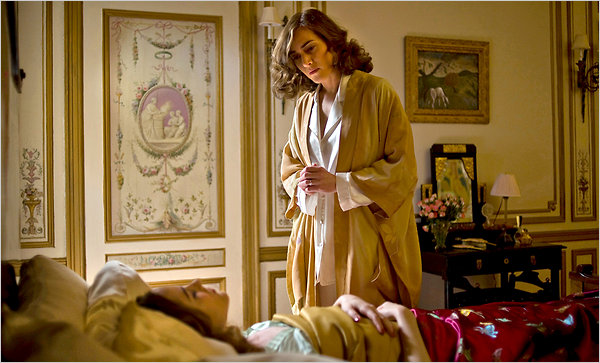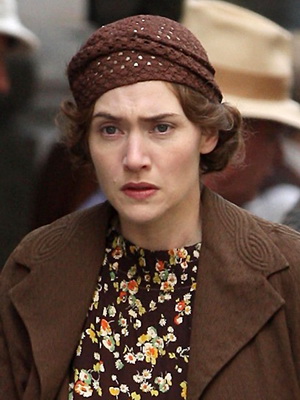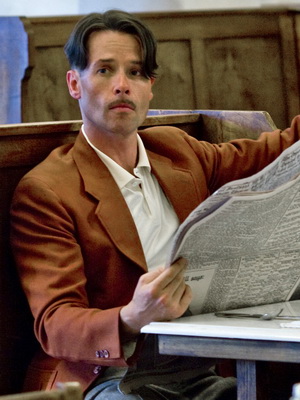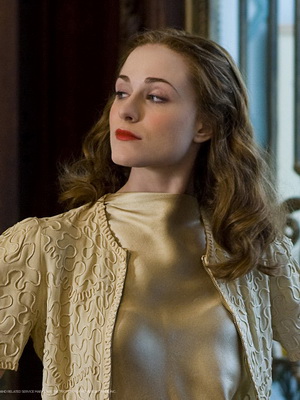Asked recently about his longstanding attraction to the melodramatic form known as the woman’s picture — “the untouchable of film genres,” as the critic Molly Haskell once put it — the director Todd Haynes had a ready answer.

Kate Winslet as Mildred Pierce and Evan Rachel Wood (in bed) as her daughter
“Stories about women in houses are the real stories of our lives,” he said. “They really tell what all of us experience in one way or another because they’re stories of family and love and basic relationships and disappointments.”
Women in houses are a staple of Mr. Haynes’s work, whether in the self-help culture of Southern California (“Safe”) or the suffocating Eisenhower-era suburbs (“Far From Heaven”). Even his cult hit “Superstar,” which used Barbie dolls to tell the story of Karen Carpenter’s losing battle with anorexia, fits that description. His newest work, “Mildred Pierce,” an HBO mini-series starring Kate Winslet (it is to have its premiere next Sunday), is his first for the small screen and, at five and a half hours, his largest in scale. An adaptation of the 1941 James M. Cain novel, it is also a revision of the mother of all mother movies, directed by Michael Curtiz in 1945 and starring an Oscar-winning Joan Crawford as Mildred, the long-suffering embodiment of maternal sacrifice.
Mr. Haynes, 50, first encountered the original film in the early 1980s as a student in the art and semiotics program at Brown University. Framed as a whodunit — it opens with the killing of Mildred’s second husband, the rakish Monty Beragon — the original “Mildred Pierce” has long been a staple of feminist film theory, which generally views it as a conflicted genre hybrid that combines the masculine conventions of film noir and the feminine ones of melodrama.
As Mr. Haynes realized when he read Cain’s novel at the urging of a friend, the novelist Jon Raymond, the noir trappings of the film — released the year after Billy Wilder’s adaptation of the pulpier Cain story “Double Indemnity” — came not from Cain but from Hollywood. There is no murder mystery in the novel, nor are there any crimes apart from shady business doings and familial betrayals. Cain’s book also has less in common with the cloistered Hollywood woman’s picture than with melodramas that plant their heroines in the thick of the real world: the unsparing films by Rainer Werner Fassbinder set during Germany’s postwar economic miracle, like “The Marriage of Maria Braun,” come to mind.

Kate Winslet as Mildred Pierce
Sensitive to the effects of the Great Depression on family and gender dynamics, Cain depicts Mildred’s relationships — with a series of unreliable men and with her self-absorbed older daughter, Veda— primarily as transactions, “played out,” as Mr. Haynes put it, “through money, through finance, through class.”
“The novel felt intensely relevant,” said Mr. Haynes, who read it in 2008, with the Great Recession looming and conversations about class in America taking on renewed significance. “I love how it links potential pathologies in maternal desire with potential excesses in middle-class yearning.”
Mr. Haynes’s longtime producer Christine Vachon, having partnered with HBO a few times through her company, Killer Films, had urged him to consider a television project, and the larger canvas of a mini-series made sense for a faithful adaptation of “Mildred Pierce.” Mr. Haynes recruited Mr. Raymond to collaborate on the teleplay, which they structured as five approximately hourlong episodes.
Over tea in the West Village recently, Mr. Haynes said he was still recovering from the sheer size and pace of the production: HBO signed on in 2009 and the 17-week shoot started shortly after. “It was like doing three feature films in the time of one,” he said. (The past year was a difficult one for him personally: his mother died over the summer while he was in production.)
The luxurious running time meant that Mr. Haynes and Mr. Raymond could preserve most of the book’s crucial events (and retain large chunks of dialogue verbatim), and it also allows the story’s darker ambiguities to sink in. “In Cain’s work there’s a perversity of the imagination that’s really exciting,” Mr. Raymond said. “He comes to some really daring and unexpected emotional nerve points.”
Even at the script stage Mr. Haynes had envisioned Ms. Winslet in the lead role. “Mildred is somebody who translates her emotional frustrations into work, but she also discovers a sort of sensual life,” he said. “I saw an equivalent in Kate’s force on screen, her physical commitment.”
For Ms. Winslet “Mildred Pierce” was an endurance test unlike any she had faced: the script was 280 pages and she would appear in every scene. “Knowing that I had to be present for that amount of screen time, that in and of itself was a challenge,” she said on the phone from Paris, where she was shooting a film with Roman Polanski. It helped that in Mr. Haynes she had a director who shared her analytical approach. “Especially in the relationship with Veda, you can’t skim over it by saying, oh, it’s complex,” Ms. Winslet said. “It was important that we discussed it fully.”

Guy Pearce
The tug of war between Mildred and her beloved Veda has a special place in the annals of mother-daughter dysfunction. Each hurts and fulfills the other in ways that usually only lovers do, and the arrogant Veda, a skilled social climber, represents all that her mother has repressed and desired.
A coloratura soprano in Cain’s book, Veda is demoted to a sleazy lounge act in the Curtiz film and memorably played by Ann Blyth as a monstrous bad seed. Mr. Haynes said he took pains to create a more nuanced Veda (played by Morgan Turner as a child and by Evan Rachel Wood as a young woman). “I wanted to give some possibility for empathy on both sides,” Mr. Haynes said. “Usually that meant making Mildred more culpable.”
“Mildred Pierce” was a departure from Cain’s claustrophobic earlier novels, and some reviewers complained about the odd mix of social realism and melodrama. According to his biographer Roy Hoopes, Cain himself wondered if his original conception of “a woman who uses men to get her ends” had been overshadowed by the imperious Veda.
But Mr. Haynes shows in his adaptation that Cain’s story is not divided against itself so much as rooted in countervailing forces. The competitive drives and separation anxieties of all maternal melodramas are here bound up in class conflict. “The daughter’s ascension represents Mildred’s ultimate goals, but it guarantees that they will have nothing in common,” Mr. Haynes said. “She’s basically sacrificing her to a different class.”
From the Mattel-manufactured cast of “Superstar” to the revolving door of Bob Dylans in the anti-biopic “I’m Not There,” Mr. Haynes has delighted in toying with audience identification. “I’m interested in experiments in narrative that force people to think about how stories are told,” he said. “But I was aware in this case of speaking to a different audience, and I respect that.”
Mr. Haynes is not constitutionally a naturalist, though, and it’s no surprise to hear him describe the naturalism of the series as itself a kind of artifice, a throwback to what he called the “dressed-down” style of the American cinema of the 1970s, when films like “The Godfather” and “Chinatown” were revising genres and, often, revisiting earlier eras.
In more than one sense Mr. Haynes’s series frees “Mildred Pierce” from the black-and-white world of noir. Besides creating more complicated versions of Mildred and Veda than Curtiz’s crime mystery, with its insistence on a solution, could have allowed, it also replaces the stylized expressionism of film noir with the rangy realism of the so-called New Hollywood. To Mr. Haynes the most resonant of the New Hollywood films, with their natural light, real locations and distanced camerawork, encouraged “an observational patience” in the viewer.

Evan Rachel Wood
Mr. Haynes and his cinematographer Ed Lachman decided to shoot on Super-16 millimeter film, a format that could retain some trace of the grain of ’70s movies, even on high-definition digital screens. The visual leitmotif of capturing actors through windows and in reflections evokes the work of Fassbinder, one of Mr. Haynes’s favorite filmmakers, and that of the photographer Saul Leiter. Mr. Leiter’s intimate, almost abstract street photographs suggested an evocative visual shorthand. “There was a reduction of information that helped us think about how to convey a whole world,” Mr. Haynes said.
Those worlds were assembled by the production designer Mark Friedberg and his team on soundstages at Steiner Studios in Brooklyn and with exteriors in the New York area that could pass, with some imported palm trees, for 1930s Los Angeles. Mildred’s journey takes her from the tract houses of Glendale to the mansions of Pasadena, and given the story’s emphasis on class aspirations, every last detail of home décor was important.
“It was a lot of world to make,” Mr. Friedberg said. “It needed to feel like Mildred’s going from one realm to another, and they all had to be distinct.”
Mr. Haynes has a reputation as a cerebral, postmodern filmmaker, but what often goes unremarked is that he is, as much as anything else, a social historian. His previous films have dealt with the construction of identity amid the social repressions of the 1950s, the utopian passions and sexual freedoms of the ’60s and ’70s, and the culture wars and New Age philosophies of the ’80s and ’90s.
With “Mildred Pierce” he looks back at the New Deal ’30s through the lens of the ’70s, which Mr. Haynes described as the last liberal era in living memory. He started working on “Mildred Pierce” as the Obama campaign was gaining momentum. “I felt we were at the end of a conservative era that we’d lived through since the ’70s, that we were on the cusp of something new,” he said.
Whether or not things turned out that way, “Mildred Pierce” is an object lesson in how the past can be used to illuminate the present. In trying to recapture the open, searching quality that defined the American cinema of his youth, Mr. Haynes invites a more engaged mode of viewing. “I wanted to see if it could work again,” he said. “The idea was to use old movies, old genres and old subject matter to trick people into thinking about their world today.”
Source: The New York Times





Leave A Comment
You must be logged in to post a comment.